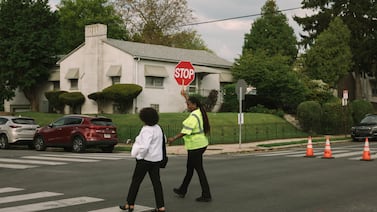Teacher and staff shortages exacerbated by the coronavirus pandemic are making it harder for Illinois school districts to find qualified teachers – especially for special education and bilingual positions, according to a new survey.
Of the Illinois school leaders from 690 school districts surveyed, 73% say they have a teacher shortage problem, 93% say the shortage is as bad or worse than last school year, 95% report receiving the same or fewer applicants for vacant positions, and 92% say they have a substitute teacher program. School leaders also said those who do apply for open roles aren’t qualified for the position.
The Illinois Association of Regional Superintendents of Schools partnered with Goshen Education Consulting for the sixth annual Educator Shortage Study, which was conducted in the fall of 2022.
In previous years, the survey focused on issues schools face to hire and retain educators and support staff while understanding what positions and geographic areas saw the most shortages. This year, the study asked school leaders what state officials could do to help schools increase staffing.
Across the state, the study found that 2,728 teacher, special education, and support staff positions were either vacant or filled with someone less qualified. While schools across Illinois are struggling to fill positions, towns and rural areas especially in east-central and west-central Illinois had more vacancies.
John Meixner, regional superintendent for the Regional Office of Education 26, said his office supports small districts in rural communities in west-central Illinois. The report reflects what he has seen on the ground, Meixner said, noting that one of the main issues for the school districts his office serves is finding applicants for vacant positions.
“I’d say 10 to 15 years ago, if an opening happened in an elementary education position a school district would have 20 applicants,” said Meixner. “Now they’re lucky to get maybe two. There are some positions where they don’t get any.”
To fill in gaps, Meixner said school districts have found retired teachers to come back to the classroom. However, retired teachers can only work for a limited amount of time to keep their pension. Districts have moved current teachers to different subject areas to fill positions, whether they have a license to teach that grade level or content area.
School leaders around the state are dealing with similar issues and would like the state to step up to help districts hire more teachers.
The survey found that 68% of school leaders believe incentivizing teachers to get additional endorsements will have a positive effect on recruiting and retaining teachers. To get students into the teacher pipeline and into classrooms, school leaders suggested scholarships for students, additional compensation for staff in high-need areas like special education, and increased funding for pension plans.
Last year, the State Board of Education created a $4 million grant to support teachers who wanted to get a bilingual educator endorsement. The state has increased the Minority Teacher Illinois Scholarship, which is aimed at increasing the number of teachers of color and bilingual educators, to $4.2 million..
In addition to a staff teacher shortage, school districts across the state are dealing with a substitute teacher shortage — which also has been exacerbated by the COVID-19 pandemic. The survey found that school leaders want state policymakers to allow retired teachers to substitute without harming their pensions, make it easier to become a substitute teacher, and increase substitute teaching days to 120 each year.
At a press conference on Monday, Mark Klaisner, president of the Illinois Association of Regional Superintendents of Schools, said the state has made investments to deal with school staffing shortages, but more funding is needed.
Klaisner and other education advocates are asking the state to invest $550 million in the state’s evidence-based funding formula “to give schools the money they need for professional development for additional education.”
“If the base funding minimum goes up, it allows us to address teacher and paraprofessional salaries,” said Klaisner. “This will help keep people where they are and make it a viable profession given the income levels.”
Samantha Smylie is the state education reporter for Chalkbeat Chicago, covering school districts across the state, legislation, special education, and the state board of education. Contact Samantha at ssmylie@chalkbeat.org.






